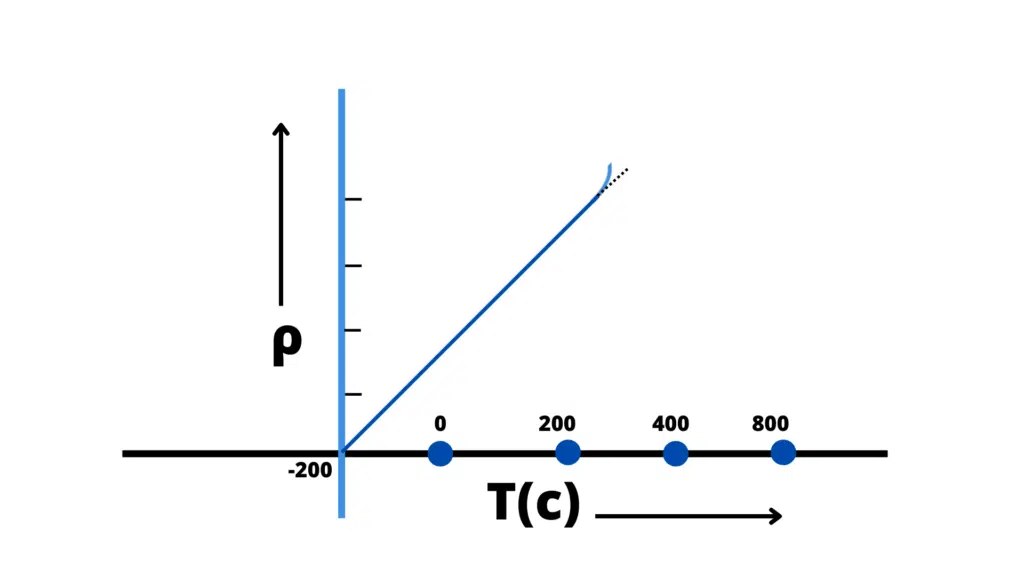Resistivity And Its Dependence On Temperature
Resistance is defined as the opposition offered by the atom of the conductor to the flow of electric current is called resistance in ohm’s law. In this article, we will learn about resistivity and its dependence on temperature.
Download the pdf notes of Resistivity And Its Dependence On Temperature Class 12 Physics
What is Resistivity?
It has been experimentally seen that the resistance of a conductor is directly proportional to its length ‘L’ and inversely proportional to its area of cross-section ‘A’,
Mathematically,
R∝L
R∝1/A
R∝L/A
R=ρ(L/A)
Where ‘p’ is the constant of proportionality and is called “Resistivity” or “Specific Resistance” of the conductor.
The resistance of a meter cube of a material is called Resistivity.
Unit of resistivity
The SI unit of resistivity is Ohm-meter (Ωm).
What is the difference between resistance and resistivity?
- Unit of resistance of ‘Ohm’ while that of resistivity is ‘Ohm-meter’.
- Resistance depends on the nature, temperature, and geometry of the wire while resistivity depends on nature and temperature only.
Conductance
The reciprocal of resistance is called Conductance.
Mathematically.
Conductance =G=1/R
Unit of Conductance
The SI unit of conductance is “mho” or “Siemen”.
Conductivity
The reciprocal of resistivity is called Conductivity.
It is denoted by ‘ σ’
σ =1/ρ
Unit of Conductivity
The SI unit of conductance is “mho-m-1“
Effect of temperature on resistance
The resistance of a conductor is due to the collisions of electrons with the atoms of the conductor.
As the temperature of the conductor rises, the K.E of the atoms increases and they vibrate with greater amplitude. Hence the probability of their collision with free electrons also increases. So the electrons find it more difficult to pass through them.
Thus the current in the circuit, which is due to the flow of electrons, decreases and we say that the resistance of the conductor has been increased.
Temperature coefficient of resistance
The fractional change in resistance per Kelvin is called the Temperature co-efficient of Resistance.
It is denoted by ‘ α’.
Suppose
Ro= Resistance of conductor at 0°C.
Rt = Resistance of conductor at t°C.
(Rt-Ro)= Change in resistance.
Experimentally, it has been found that the change in resistance is directly proportional to the original resistance and the rise in temperature.
Mathematically,
Rt-Ro∝ Ro
Rt-Ro∝t
Rt-Ro∝ Ro t
Rt-Ro= α Ro t
α= Rt-Ro/ Ro
Since resistivity is directly proportional to the resistance, therefore in terms of resistivity can be expressed as:
α= ρt– ρo/ ρot
‘ α ‘is called the “Temperature co-efficient of Resistivity“

Temperature coefficient of resistivity:
The fractional change in resistivity per Kelvin is called Temperature co-efficient of Resistivity.”
Unit:
The SI unit of temperature coefficient of resistivity ‘ α ‘ is K-1
Differentiating metals:
Two or more metals may have the same resistivity but different values of α. Thus α can be used in differentiating between two metals.
Negative temperature coefficients:
Resistances of some substances like germanium, silicon, etc, decrease with an increase in temperature. Thus these substances have negative temperature coefficients.
Frequently Asked Questions-FAQS
What is resistivity?
The resistance of a meter cube of a material is called Resistivity.
What is the effect of temperature on resistivity?
The resistivity of some material like germanium, silicon, etc, increase by increasing the temperature.
What is the resistivity formula?
The formula of resistivity is
R=ρ(L/A)
Where R is resistance L is the length of the conductor and A is the area.
What is the resistivity of material?
The resistivity of the material can be defined as the resistance offered to current flow by a conductor of unit length having a unit area of cross-section. The property of the material does not depend on the physical dimensions.







Leave a Reply